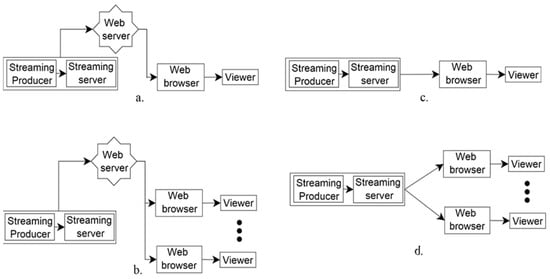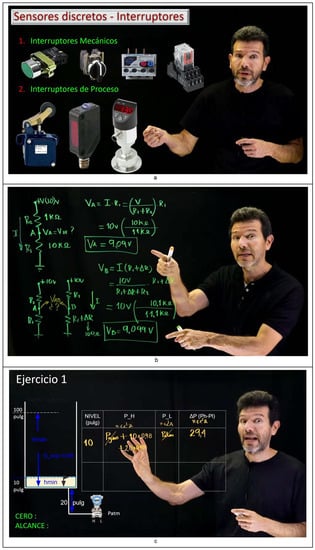Immersive virtual classroom (IVC) is a streaming platform that incorporates an augmented reality component into the materials used in synchronous learning and allows the production of engaging audiovisual educational resources as instructional videos. It requires no post-production time and was developed during the COVID-19 pandemic at the University of Cauca. IVC performs a live composition of audiovisual material (type slides) with video of the instructor, allowing an online interaction between the instructor and their slides while the interlocutors watch in a live transmission in full HD quality (1920 × 1080 pixels) and interact with the instructor via audio using a conventional videoconferencing platform.
1. Introduction
Warden et al.
[1] conducted, for the first time, a nine-year action research study on synchronous distributed learning environments supported by videoconferencing technology up to immersive virtual reality environments. Regarding the experience with limited videoconferencing technologies in the first decade of this century, Warden et al.
[1] emphasize the audio factor (the main issue is audio feedback) on video quality and the need to integrate different support tools when lecturing (such as chat, mute, hand raising and presentation synchronization). Regarding the experience in immersive virtual reality environments for a large online class to participate with effective instructional delivery, Warden et al.
[1] highlighted findings that need to be addressed, such as:
- -
-
As with videoconferencing technology, the audio feedback problem persists, compounded by the fact that distance between the avatars changes the audio intensity and makes it difficult to identify open-mic problems in large classes.
- -
-
Students’ unwanted manipulation of the space can be controlled with program restrictions, and engagement can be increased with more interesting designs and a richer virtual world. However, designing complex locations and buildings close together can be counterproductive, as this invites exploration. Glass walls and open spaces are preferable so that all avatars can see each other.
- -
-
Objects within the virtual space require strong management to prevent accidental manipulation by an individual student and the widespread confusion that can result. Another control issue arises because the instructor cannot be sure that students are following instructions or even arriving at designated locations, so the instructor may be overwhelmed by the complexity of the virtual space when managing the class.
A decade after this first research work, videoconferencing technology and virtual world control have improved. However, the pitfalls and promises of learning in immersive virtual reality (IVR) that Mayer et al. mentioned in
[2] are still prevalent. A 3D virtual environment with a head-mounted display implies a high degree of immersion, whereas a 2D virtual environment delivered on a computer screen implies low immersion. According to the cognitive theory of multimedia learning
[3][4], IVR promises to increase the motivation to learn, which in turn increases generative processing (anchoring learning by relating it to prior knowledge). However, the pitfall of IVR is increasing learner distraction due to the richness and novelty of the 3D virtual environment, which decreases essential processing (representing what is being taught in their working memory), as the learner focuses on extraneous processing (which does not support the instructional goal) when exploring the “highly” immersive virtual reality
[2]. In contrast, the promise of conventional media (instructional videos, desktop and slideshow) is that they present less extraneous processing, freeing up capacity for the learner’s essential and generative processing. In addition, if the lesson is well designed, it will focus on the essential material, resulting in better essential processing. The pitfall, however, is that the learner may need to be more motivated to engage with the material being taught and will, therefore, show less generative processing
[2].
According to Mayer et al.
[2], the challenge for instructional designers using IVR is to minimize extraneous processing while maintaining appropriate levels of generative and essential processing, whereas the challenge for designers using conventional media is to foster a high level of generative processing while maintaining the presentation of a well-organized lesson. To meet this challenge, Mayer et al.
[2], in their own experience of 13 comparative experiments on learning outcomes achieved with conventional media versus IVR, concluded that these 13 comparisons did not provide “strong” evidence for the effectiveness of learning academic content in IVR compared with learning with conventional media. One reason is that learning in IVRs can distract students, an observation made previously by Warden et al.
[1]. Finally, Mayer et al.
[2] concluded that the effectiveness of academic-content-related lessons presented in IVR can be improved by adapting instructional design principles (such as modality, personalization and pre-training principles) and by incorporating generative learning activities (such as summarizing, responding and enacting).
This indicates that learning with both conventional media and IVR could benefit from the good use of both internal factors (instructional design principles) and external factors (generative learning activities). This suggestion could be extrapolated to synchronous learning with videoconferencing platforms. However, although the experience with videoconferencing platforms is much more friendly today, there are more tools unified to videoconferencing (such as surveys, interactive boards, grouping, etc.), the video at both ends is still not high resolution and specific audio problems persist. Therefore, it is necessary to propose to study the perception that this would have on synchronous learning, not the use of a limited videoconferencing platform but the use of live streaming platform supported in augmented reality as an intermediate solution for the low immersion (involves a 2D virtual environment delivered on a computer screen) between current videoconferencing technologies and IVR.
2. Immersive Virtual Classroom in Synchronous Remote Learning
Four features determine the functionality of IVC in online synchronous classrooms between an instructor and their students: (a) interactions, (b) IVC modes, (c) streaming type and (d) augmented reality type.
2.1.1. Interactions in IVC
Student–instructor and student–student interactions occur more often in a F2F classroom than in a synchronous online learning environment. However, the outcome of these interactions is highly dependent on class dynamics and the freedoms that an instructor applies during class
[5]. During a synchronous class in IVC, as in blended courses, student–instructor, instructor–content and student–student interactions can occur according to the instructor’s teaching–learning dynamics
[6]. However, in an IVC, an instructor can perform real-time augmented reality instructor–content (material taught on slides) interaction during the synchronous class. This real-time interaction allows the instructor to perform pointing gestures, eye contact and gaze orientation, thereby enhancing his or her social presence.
2.1.2. IVC Modes
An IVC uses an automated streaming studio that generates the necessary lighting conditions and audiovisual feedback to create an augmented reality environment for the instructor (see Figure 1a). In the studio, the instructor is positioned behind a dark curtain and lit from three points. As the instructor’s video is composited in real time with video of the slides, the instructor can perform two types of interactions. The first is with the material being taught, thanks to a clicker and visual feedback provided by a composite video monitor. The second level of interaction is with the students via audio, thanks to a traditional videoconferencing platform (see Figure 1a).
Students have three types of locations in the IVC: (a) distributed: students are geographically dispersed, each connected from a device with an Internet connection, preferably using a hands-free system (see Figure 1b), (b) concentrated: students are in a classroom with an Internet connection and a mic to allow audio interaction with the instructor (see Figure 1c) and (c) hybrid: this case involves both concentrated and geographically dispersed students in the same session. In all three modes, it is possible to have feedback from the students’ video webcam or from the classroom to the instructor via a second monitor.
2.1.3. Streaming Type in IVCs
IVCs have four types of live streaming, depending on combinations with or without video server mediation and one-to-many or one-to-one:
-
Type 1: The traditional video server—one-to-many. This is how commercial video streaming platforms work. The instructor produces the audiovisual material, transmits it to the cloud and a commercial video server distributes it to the student consumers with a certain quality and delay. Depending on the type of configuration used in the streaming platform from the producer’s side, there can be delays of 2–5 s at the consumer side. Type 1 is associated with distributed and hybrid IVC modes (see Figure 2a).
-
Type 2: Video server—one-to-one. This occurs when the consumer is unique or all students are confined to a single location. Delays of 2–5 s or less also occur, depending on the type of configuration used in the streaming platform. Type 2 is associated with concentrated IVC mode (see Figure 2b).
-
Type 3: Simple peer-to-peer only requires an initial server to connect the IP addresses of the video producer’s computer to the video consumer’s computer; once connected, no additional servers are required and a high-quality bi-directional connection is established. Delays are in the millisecond range. Type 3 is associated with the concentrated IVC mode (see Figure 2c).
-
Type 4: Multiple peer-to-peer requires an initial server to connect the IP addresses of the video producer’s computer to the computers of a small number of video consumers. Once the link is established, no further servers are required and a one-to-many connection is established, the quality of which depends on the hardware capabilities of the producer’s computer. Delays are in the order of milliseconds. Type 4 is associated with distributed and hybrid IVC modes (see Figure 2d).
2.1.4. Type of Augmented Reality in IVCs
The IVC allows three types of augmented reality in the audiovisual material generated for both synchronous and asynchronous learning.
- -
-
Type 1. The first type combines the audiovisual material prepared for the lesson with the instructor’s video against a black background. In this type of augmented reality, the student observes how the instructor interacts with the audiovisual material through pointing gestures, eye contact and gaze orientation. This interaction takes place thanks to the visual feedback the instructor receives through a monitor (see Figure 3a).
- -
-
Type 2. The second type of augmented reality is generated by simply drawing and writing the prepared lesson material with fluorescent markers on a transparent board and horizontally inverting the video before recording or streaming it (see Figure 3b).
- -
-
Type 3. The third type combines the previous two types of augmented reality. This third option takes advantage of the ease of preparing visually appealing material with the ability to write on a transparent board with fluorescent markers. The IVC combines the two videos in real time and provides visual feedback to the instructor, allowing them to interact with the audiovisual material and the writing on the board (see Figure 3c).
3. Conclusions
The IVC is a virtual classroom model that allows both synchronous online classes and the generation of audiovisual educational resources in the form of instructional videos with augmented reality elements that is more engaging and has a low level of post-production. The COVID-19 pandemic has made it possible to experiment and improve virtual classroom models supported by videoconferencing and evaluate teaching–learning models for F2F, blended and online environments. Given the current limitations of videoconferencing platforms and the need for further research in instructional videos on how to integrate aspects such as instructor characteristics and content presentation, it is recommended to experiment with transparent whiteboard and instructor behind-the-slides video styles in both asynchronous and synchronous learning, thus taking advantage of both the social and instructional presence of the instructor by producing audiovisual material without high post-production costs.
This entry is adapted from the peer-reviewed paper 10.3390/info14100543


 Figure 3. Three types of augmented reality generated with the IVC.
Figure 3. Three types of augmented reality generated with the IVC.